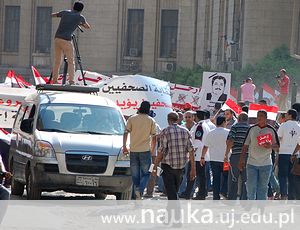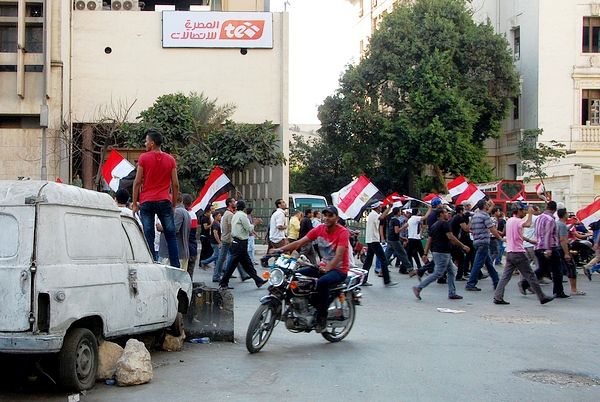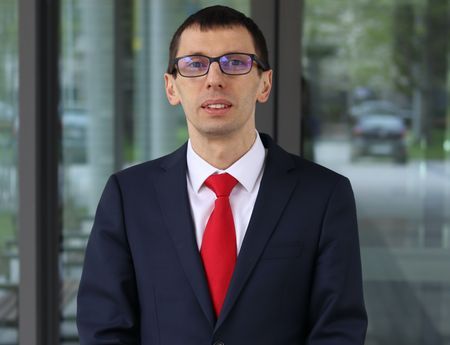
The political upheaval in the Middle East has led to diverse outcomes. Countries that share many similarities headed in completely different directions. Governments were overthrown, civil wars erupted, political reforms were introduced, but in some states political systems remained unchanged. We asked Dr Łukasz Fyderek from the JU Faculty of International and Political Studies to explain these differences.
The Middle East in the early 21st century. Countries with similar culture and stable regimes, whose official ideologies combined Arab nationalism with republicanism and some form of resistance towards the West. And suddenly, contrary to most experts’ predictions, these states have undergone rapid changes.
Three factors
 Tunisian protests have quickly led to the flight of President Ben Ali (Zin el-Abidin Ben Ali). The following wave of protests swept Egypt. Then the unrest spread to Libya, Yemen, Bahrain, and Syria. In this context, some commentators started to use the phrase ‘Arab Spring’, which referred to the Western perception of Central European revolutions of 1989. Yet, it turned out that the Arab Spring had little to do with the political changes in the Old Continent.
Tunisian protests have quickly led to the flight of President Ben Ali (Zin el-Abidin Ben Ali). The following wave of protests swept Egypt. Then the unrest spread to Libya, Yemen, Bahrain, and Syria. In this context, some commentators started to use the phrase ‘Arab Spring’, which referred to the Western perception of Central European revolutions of 1989. Yet, it turned out that the Arab Spring had little to do with the political changes in the Old Continent.
The Arab Spring developed according to several different scenarios. One of them was the fall of regime, the flight or arrest of dictator and the start of a democratic political process. This was the case of Tunisia and Egypt. Events took a different turn in Libya, Syria and Yemen, where the upheaval resulted in the outbreak of civil wars. Yet another scenario unfolded in Bahrain, a small country with an authoritarian-leaning monarchical system, where the revolution was crushed with the help of armed forces of Saudi Arabia and the United Arab Emirates.
How did it happen that some states, such as Tunisia and Egypt, followed the path of a relatively peaceful transformation, whereas in other places, revolutions led to wide-scale violence? The most plausible hypothesis points to three major contributing factors.
Tribal loyalty
The first factor is related to the basis of the regime, which isn’t formed by rational institutions or organisations, such as a political party or armed forces, but by the basic ties of family, clan, and tribe. The Arab countries ruled by such regimes didn’t follow the path of peaceful transformation.
In Libya, Syria and Yemen, the ruling group was bound together by something more than institutional ties. The Hashid tribal confederation, to which the Yemeni president belonged, remained faithful to him until the end. Finally, the president resigned from office, but retained influence over crucial military units and the security apparatus, dominated by officers from the loyal tribes.
The situation in Yemen and Libya had much in common. The structure of Libyan state at the final stage of Muammar Gaddafi’s rule was very weak. Gaddafi’s personality cult and his suspicions against the military led to a situation that besides one brigade dominated by members of the dictator’s tribe, the army and security forces actually didn’t exist as a fighting force. When the revolution broke out, the protesters easily captured military warehouses, whereas the aforementioned brigade, under Gaddafi’s son’s command, engaged them using heavy weapons. Like in Yemen, the soldiers remained faithful to the dictator because of personal loyalty. In the case of Libya, this situation led to a military intervention by a coalition of some Arab and European states supported by the US.
 The Syrian case was similar, but it also had some unique features. Tribalism in Syria isn’t so important as its society has longer urban traditions and is based on a mixture of sectarian and clan ties. The ruling elite has long been dominated by members of the Shia Alawite sect. This relatively numerous group, which has about 2 million members in Syria, occupied most positions in security forces, key military units and military intelligence. When riots broke out, the Shiites knew they couldn’t abandon the president, as the rest of society perceived them primarily as members of his religious group, similarly to members of Gaddafa tribe in Libya and Hashid confederation in Yemen.
The Syrian case was similar, but it also had some unique features. Tribalism in Syria isn’t so important as its society has longer urban traditions and is based on a mixture of sectarian and clan ties. The ruling elite has long been dominated by members of the Shia Alawite sect. This relatively numerous group, which has about 2 million members in Syria, occupied most positions in security forces, key military units and military intelligence. When riots broke out, the Shiites knew they couldn’t abandon the president, as the rest of society perceived them primarily as members of his religious group, similarly to members of Gaddafa tribe in Libya and Hashid confederation in Yemen.
On the other hand, the transformation in Tunisia and Egypt bore much similarity to processes that took place in Central Eastern Europe, where Soviet imposed Communist rule was overthrown a quarter of century before. During the relatively peaceful transition, the dictator and part of the ruling elite were ousted from power, whereas the rest “made a deal” with the newly emerged forces. It should be noted that the Tunisian and Egyptian regimes weren’t based on family and tribal loyalties, as tribalism doesn’t play a major role in these societies due to their long history of urbanisation.
Kings and wealth
The second factor impacting the trajectory of changes is related to the legitimisation of the regime and the system. Monarchies turned out to be more resilient to the outbursts of dissatisfaction than republics. Besides Bahrain, the mass protests mainly occurred in republics ruled by presidents. In monarchies, the rulers have inspired much more public trust. It seems that in the contemporary Middle East monarchs have more legitimacy than hereditary presidents. That’s why the scale of protests in Morocco or Jordan was relatively small.
The third factor is of a purely material nature. The governments of oil-rich states had enough resources to do what they’ve been doing for years, that is, buy the citizens’ loyalty. This is what happened in Saudi Arabia, Kuwait, the United Arab Emirates, and Algeria – the only Arab republic that remained free from the unrest. Responding to social upheaval by increasing social spending is a well known practice, which can only be employed by the so-called ‘rentier states’, that is countries whose wealth is primarily based on extraction of fossil fuels, rather than taxing labour and capital.
The diverse scenarios of change that have occurred in the Arab world since 2011 provide a wide range of research topics for comparative political science. The analysis of events unfolding in the Middle East can tell us a lot about the conditions of successful and unsuccessful governmental changes, the use of violence in authoritarian systems, the mechanisms leading to civil war, and key moments in political crises. Studies from the area of comparative political science may also lead to a better understanding of the systemic transition in Poland, which has so far been analysed almost exclusively from the historical point of view, with little comparison to changes in political systems in other parts of the world.
Original text: www.nauka.uj.edu.pl





